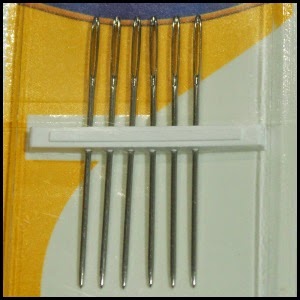 |
| My brother's first stitching project. Pattern is from a World Of Cross Stitch magazine |
As I started putting this blog post together, it became bigger than Ben Hurr, so I decided to break it down into different posts. As I write each one, I'll update the links here:
- The essential materials
- Starting Off
- The Cross Stitch
- The Back Stitch
- The Half Stitch
- The French Knot
- Beading (from last week)
- Stitching on Evenweave
This week is
The Essential Materials
The Thread
Cross stitch thread comes in bundles known as skeins. It is a long length of thread, made up of 6 individual strands. Most stitches require either one or two strands of thread to work the design. Two threads gives a thicker appearance and covers the fabric better. One strand tends to be used for backstitch. I store my threads on bobbins to keep them organised so I can find the desired number quickly, and to stop them becoming tangled.

There are many different brands of cross stitch thread, however the main ones are DMC and Anchor. I tend to use DMC as that is what my mother was collecting when I inherited her stash
To start stitching, unwind the desired length of thread from the skein or bobbin and cut it off. I like to have a length about as long as my arm so that I don't have to come back for more as often. However, shorter lengths do not become as tangled. If you are new to cross stitch, a length approximately 20 to 30 cm is a good place to start.
There are many different types of cross stitch fabric around - aida, cotton evenweave, linen, zweigart linda, hardanger, crewel, plastic canvas, stitching paper... the list is endless. They come in a multitude of colours and sizes and everyone has their own preference. There is a great description on some of the different types of fabrics here.
The main types I use are aida and evenweave.
 Aida is woven into blocks, which creates squares for you to stitch over. Because it is so easy to see the squares, it is an ideal fabric for the beginner stitcher. It comes in different sizes - 6, 8, 10, 12, 14, 16, 18. These sizes relate to the number of squares per inch - the bigger the number, the smaller the squares on the fabric.
Aida is woven into blocks, which creates squares for you to stitch over. Because it is so easy to see the squares, it is an ideal fabric for the beginner stitcher. It comes in different sizes - 6, 8, 10, 12, 14, 16, 18. These sizes relate to the number of squares per inch - the bigger the number, the smaller the squares on the fabric.Evenweave contains lots of strands of flax. It tends to be more uneven than aida. The holes in the fabric are smaller, and stitches are made over two strands or holes rather than one. Evenweave sizes (22, 24, 26, 28, 32 holes per inch) tend to be double that of aida - for example 14 count aida is approximate to 28 count evenweave.
The Needles
Needles used in embroidery are blunter than those used for general sewing. Because the holes are already present in the fabric, you don't need a very sharp needle to push through. Tapestry needles also have large eyes, which makes it easier to thread them. Needles come in a variety of sizes depending on how thick they are. The larger count fabric you are using (remember - smaller holes), the thinner needle you should use so you don't stretch out your fabric. I came across a really handy guide here that discusses the correlation of needle and fabric size for cross stitching.
The Scissors
It is important to have a sharp pair of embroidery scissors when stitching. And that they aren't used for anything other than cutting threads or fabric! Paper will blunt your scissors pretty quickly.
The Hoop
I find it essential when stitching to use a hoop or frame. This helps keep the fabric taught which means that your stitches are more even. It also gives you something to hold on to rather than your fabric, reducing the stains caused by the oils in your sweat and any dirt on your fingers.
My favourite frame at the moment is the Q-Snap frame. It comes in a range of sizes that can be joined together to create even more sizes and shapes, and doesn't squish my stitches as much as a hoop does.
The Measuring Tape
Essential for measuring out your fabric prior to using it - so that you know you have enough before you start stitching.
(Plus he's just so cute I had to include him!)
Coming up...
Over the next few weeks, I will show you some the main stitches involved in cross stitch, including the cross, the backstitch, the half stitch, and the dreaded french knot. I'll also show you how to stitch on evenweave, which is my preferred stitching fabric.
Happy Stitching!
Happy Stitching!





Nice fabric work. Jacket Back Digitizing Good job.
ReplyDelete